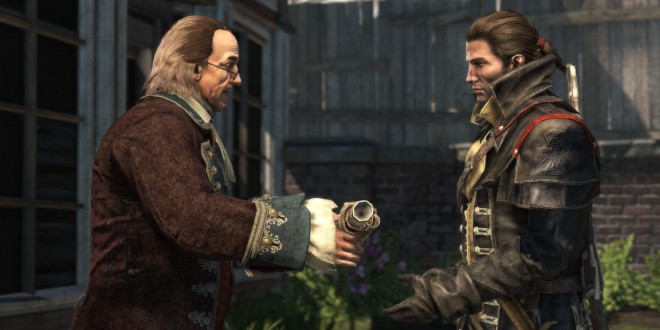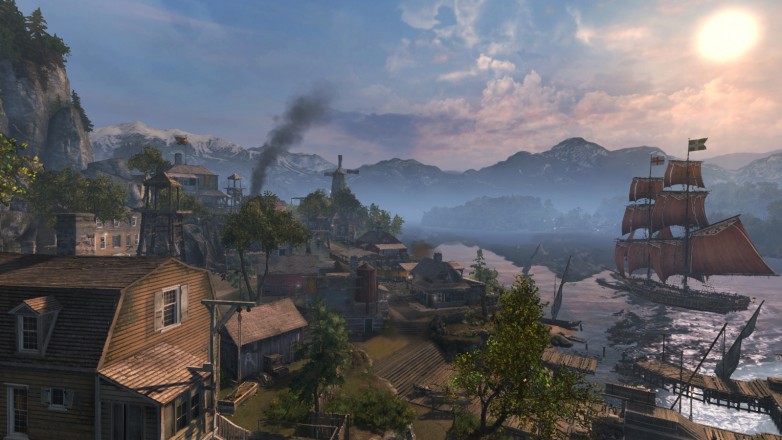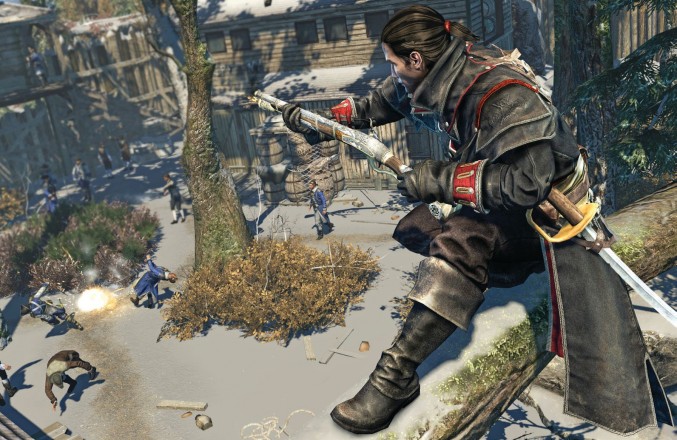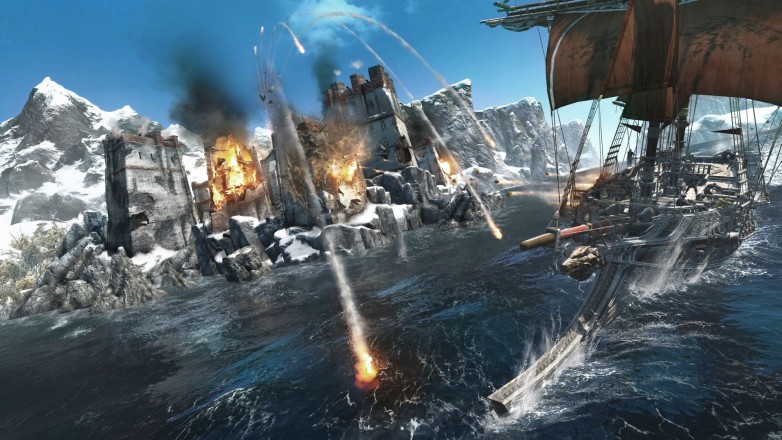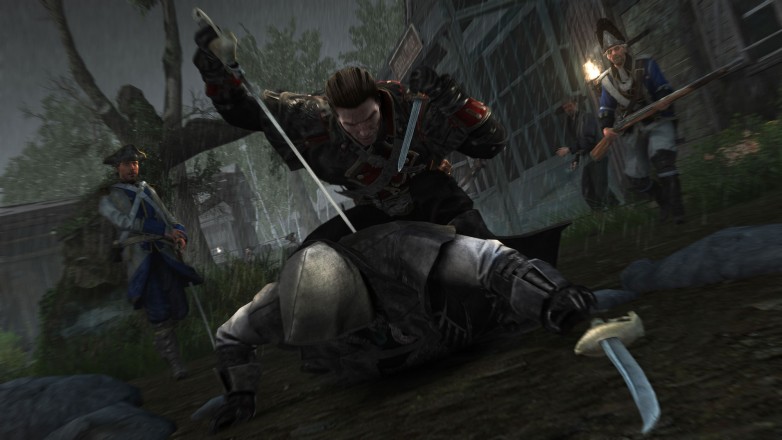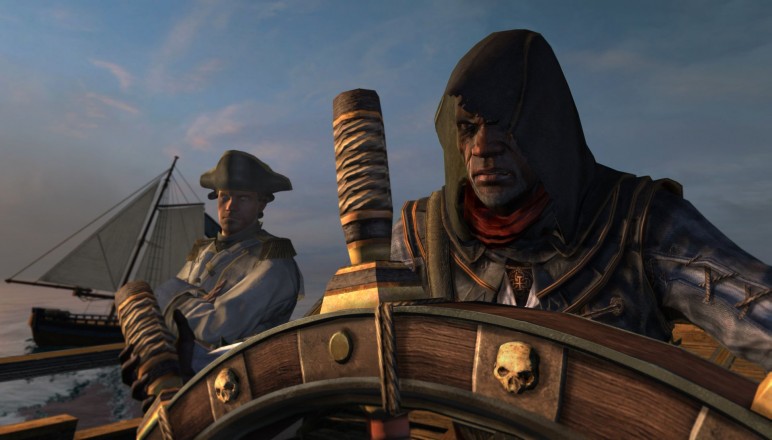Yes, Assassin’s Creed Rogue is only on the last generation of consoles, and yes, it doesn’t feature Assassin’s Creed Unity’s spectacular free-running mechanics nor does it look as good as the French Revolution. Having said that, after going through the entire campaign and spending lots of hours taking down forts, collecting templar treasures, upgrading the franchise’s newest vessel or simply strolling around the North Atlantic and other regions, I can without any doubt say the PlayStation 3 and Xbox 360 went out with a bang when it comes to publisher Ubisoft’s most popular series.
Right from the very beginning, players take on the role of Shay Patrick Cormac, an assassin from the North American brotherhood. During Assassin’s Creed Rogue’s first few hours, your main task is to intercept a relic and a few manuscripts which the templars seek to understand and eventually use for their own schemes. What’s interesting to witness here is the fact that right from the get-go, it’s pretty clear Shay doesn’t feel at home with the assassins. He feels like he’s too good for them; that some are too bossy and don’t pay him the proper respect. When disaster strikes – even though everyone is surprised by said chain of events – Shay blames Achilles, the North American master, and thus leaves the brotherhood and slowly starts working for the templars.
On a happier tone, seeing the homestead from Assassin’s Creed III up and running, full of assassin recruits and masters alike going about their daily lives is a nice treat. Not to talk about seeing a younger Achilles, an older Adéwalé, and even other returning characters like Benjamin Franklin or the always-fan-favourite Haytham Kenway. Moreover, while I’m not complaining about Edward – as he’s my favourite assassin so far – an actual assassin like Shay makes much more sense when it comes to sneaking around, climbing buildings and trees, and silently taking out the competition. You wouldn’t really see a pirate do all that.
The modern-day story also returns, and it’s as boring as that of Assassin’s Creed IV: Black Flag. Just like in Black Flag, these section allows you – a no-name, faceless protagonist – to wander around an office building owned by Abstergo Industries, the modern-day templars, and hack stations for additional information on the global war spanning thousands of years. Collectibles also make a return, offering further insight into the company; some even talk about protagonist Arno from Assassin’s Creed Rogue’s “big brother,” Assassin’s Creed Unity.
Much like the “in-Animus” gameplay, the atmosphere in the present-day is also darker when compared to Black Flag’s. The offices are mostly deserted and crawling with security, and Assassin’s Creed Rogue’s “boss” seems like he’s a villain ripped straight out of a classic comic-book. It somehow makes those few minutes outside the Animus more bearable, although it’s still clear Ubisoft hasn’t a clue what to do with the overall story. It’s like the studio is just stalling until the next best idea comes around.
While predictable and surprisingly short, Rogue’s story is still worth a look. It’s especially worth experiencing the very last sequence, which directly leads into Assassin’s Creed Unity. Shay and the rest of the cast do a decent job at presenting us the struggles of both sides, although no one is as memorable as Assassin’s Creed II or Assassin’s Creed IV: Black Flag’s cast.
Assassin’s Creed Rogue offers some surprisingly engaging set-pieces, which are definitely among the best ones the franchise has to offer. I’m not going to spoil much, but let’s just say getting away from the assassins has never been so fun. Well, to be honest, it hasn’t been at all, since Rogue is the first to do it.
Unlike the paradisiac nature of Black Flag’s West Indies, Assassin’s Creed Rogue welcomes players into the chilling North Atlantic, where snow and ice are the predominant forces. As a result, idling into the water for even several seconds results in your health bar starting to be reduced. Assassin’s Creed Rogue features three, huge locations – the North Atlantic, a warmer place called River Valley which closely resembles Assassin’s Creed III’s frontier during summer, and New York.
When sailing out in the open, entering in restricted areas around the map will have enemy ships engage Shay if he enters in their line of sight. Floating goods can be picked up along the way, although destroying other ships, capturing settlements or raiding an outpost still remain the main methods of upgrading your own vessel. Using Shay’s spyglass allows you to determine the strength of an enemy ship, in addition to its cargo. After you’ve captured a ship, you can either use it to repair the Morrigan, add additional funds to your “bank,” or send it to your fleet (I’ll get to that in a bit). As expected, upgrades done to Shay’s ship range from a sturdier hull to more cannons, more room for your men and ammunition, and even harpooning. Finding blueprints scattered around the world unlocks even better upgrades, so – once again – exploration is highly advised.
Assassin’s Creed II has the villa, Assassin’s Creed III has the homestead, and Black Flag has Edward’s small island. In Assassin’s Creed Rogue, income is automatically generated by renovating the entirety of New York, through templar means. As mentioned above, materials are used to improve Shay’s ship, although they are also necessary to build new structures around the third major area found in the game.
Remember the notoriety system first introduced in the second instalment? Assassin’s Creed Rogue also features it, although now, instead of being notorious for killing guards, you will start drawing the attention of bounty hunters by killing civilians. Yes, being a templar allows you to freely kill anyone without the fear of being “desynchronised.”
Once again, just like in Black Flag, capturing an enemy fort – be it in the River Valley or the North Atlantic – will reveal several points of interest on the map, such as collectibles like chests or pieces of Animus. Additionally, the mini-game in which you would send ships to other parts of the world is also back. Doing so – and assuming said vessels make it in one piece – will unlock you various customisation pieces for the Morrigan and collectibles items for your cabin.
One new addition to Rogue is the ability to get boarded by enemy ships. It’s nothing too fancy, but it at least adds to the realism of ship warfare. Besides that, your newest ship is now equipped with the ability of leaving a trail of fire behind you – much like Black Flag’s gun-powder-filled barrels – in addition to semi-automatic cannons posted all around your ship, which actually replace the auto lock-on ability from previous AC games (AC III and Black Flag, to be more precise). Another new idea thrown in is the ability of destroying small icebergs which then create waves that can damage enemy ships.
Hunting and harpooning make a return, and – just like in Black Flag – materials acquired are used to craft upgrades for Shay, which range from pistol holders to increasing your health, unlocking new outfits or even crafting new darts, grenades, and rope-arrows. Each (side) mission comes with its own optional objectives, which range from completing certain tasks in a specific amount of time to not losing more than 50% of your health. Assassin’s Creed Rogue also offers you tons of collectibles. From sea shanties to Animus fragments, chests containing gold, templar maps giving you the location of a relic or letters which further delve into the game’s lore, there’s a lot to do and collect in Ubisoft’s final entry in the North American saga.
Just like in Black Flag, Assassin’s Creed Rogue features Abstergo challenges, which basically amount to secondary objectives which can be completed outside or during any mission; objectives like assassinating a specific amount of targets, synchronizing every location on the map, killing a specific amount of targets from hiding places, and so on. By the time you finish the campaign, you’ll more than likely complete the majority of said side-quests, but the rest are a nice incentive to sink (see what I did there?) in a few more hours of play-time.
Being built on the same engine, Assassin’s Creed Rogue is also plagued with imprecise controls. As it was the case with every last Assassin’s Creed, the tried and tested formula of free-running is a treat when you’re just jumping from one place to another, but try to make a specific jump or hang from a desired ledge and you might very well either fall to your death or raise the alarm and turn your careful execution into a total massacre.
Combat in Assassin’s Creed Rogue is exactly the same as in Black Flag. You can either straight up spam the attack button or parry incoming blows and then either instantly kill said enemy, disarm him, or use a tool like the rope-dart or a smoke bomb. Nothing has changed, meaning combat is as easy as ever, and choosing the stealthier approach – stabbing from behind/above/below or simply avoiding enemy soldiers/assassins by hiding in various places like bushes – remains an option, not a necessity.
While Edward Kenway used more primitive methods when it came to firing sleeping/berserk darts, Shay is a bit more advanced, using instead a silenced rifle. Additionally, later in the game, players also unlock berserk, shrapnel, and sleeping grenades. Besides weapons, Shay can also be customised with several outfits, most of which can be purchased. Others can be unlocked via Uplay, while the rarest of them can be obtained by collecting several artefacts. It’s Black Flag all over again, but I wouldn’t have it any other way. If it ain’t broke, don’t fix it, right?
Obviously, Eagle Vision also makes a return. For newcomers to the series, this Eagle Vision is like a sixth sense which allows assassins to better spot their enemies and objects of interest. It also allows players to tag up to ten enemies – including animals – giving the ability to see them through walls.
Another unique aspect to Assassin’s Creed Rogue – this being the most important – is the addition of assassin enemies. While their attacks don’t instantly kill you, they do quite the damage. Not to talk about the assassins’ usage of smoke bombs, darts or bushes, most of them looking like normal citizens until you draw them out using firecrackers or spotting them via Eagle Vision. Every trick you used in previous games is being utilized here, against you. Naturally, instead of cleaning out templar hideouts, you will now draw the assassins away from New York by capturing several settlements, thus “rescuing” a part of the city and unlocking more content. While this cat-and-mouse style of gameplay is nothing new to the series, the idea of stalking your stalkers is a really nice change of pace and an interesting take on the other side of the conflict.
Remember the pigeons used to inform you of potential templar targets to kill in past Assassin’s Creed games? Well, now that you’re a templar, tables have turned. Instead of simply adding the same mechanic only with Shay killing assassins instead of templars, Ubisoft has decided to make things a lot more interesting. Now, instead of visiting pigeon coops, players can intercept said pigeons out in the open, learn about the assassins’ next target, and then try to defend it from the incoming killers.
As I mentioned above, being built on the exact same engine as its predecessor, Assassin’s Creed Rogue looks great at a distance, although it loses some of that charm when getting up-close and noticing some rough bushes or pieces of cloth. Still, the weather effects like rain and snow more than make up for the occasional immersion-breaking moments, especially during the night. For a last generation console title, Rogue is still quite the looker.
Review Overview
Load The Game's Verdict - 8.9
8.9
Great
When looking at Unity and Rogue side-by-side, you might believe PS3- and 360-only owners are being treated as second-class citizens. In that case, you couldn’t be more wrong. While the story is predictable and some audio bugs might annoy you from time to time, Assassin's Creed Rogue's various additions make it just as important as other entries in the franchise. Before heading into Arno’s revolution, make sure to give Shay’s rebellion a chance.
 Load the Game Video Games, Reviews, Game News, Game Reviews & Game Video Trailers
Load the Game Video Games, Reviews, Game News, Game Reviews & Game Video Trailers
